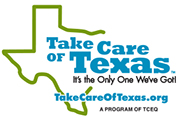Nonpoint Source Pollution: Public Education
Materials for communities, schools, groups, and others to participate in the Nonpoint Source(NPS) Pollution public education campaigns.
What Is Nonpoint Source Pollution?
Nonpoint source (NPS) pollution results when small amounts of contaminants from a large number of sources are carried by rainfall runoff into streams, lakes, or bays. For example, pollutants may be washed off lawns, construction areas, farms, or highways during a heavy rain and carried to a nearby creek.
Publications
- Water Recycles Poster (GI-403): color poster (18" x 22") that illustrates steps in the water cycle and several human activities that affect water. Back of poster has narrative information on water as well as activities and puzzles.
- Water Education Field Guide (GI-026): Guide for engaging 4th to 8th grade students in hands-on field study of Texas waters.
Other Resources
-
Guide to Lawn Care: Helps you maintain a healthy yard, save money, and take care of our state's varied landscapes.
- Storm Water Outreach Materials : materials and resources for citizens, state or local governments, and construction site operators to educate communities about storm water runoff.
- Nonpoint Source Outreach Toolbox : collection of local and national outreach materials for use and sharing by citizens and local governments to educate communities about NPS pollution.
-
Galveston Bay Estuary Program NPS of Pollution Action Plan: developed to reduce and eventually eliminate harm from nonpoint sources entering Galveston Bay.
-
EPA's SepticSmart : encourages homeowners to take steps to maintain their home septic systems, preventing costly repairs and pollution to local waterways. This national program also provides tools and materials for local and regional outreach programs.

